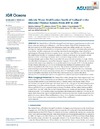Identificador persistente para citar o vincular este elemento:
https://accedacris.ulpgc.es/jspui/handle/10553/74649
| Campo DC | Valor | idioma |
|---|---|---|
| dc.contributor.author | Athanase, Marylou | en_US |
| dc.contributor.author | Provost, Christine | en_US |
| dc.contributor.author | Pérez Hernández, María Dolores | en_US |
| dc.contributor.author | Sennéchael, Nathalie | en_US |
| dc.contributor.author | Bertosio, Cécilia | en_US |
| dc.contributor.author | Artana, Camila | en_US |
| dc.contributor.author | Garric, Gilles | en_US |
| dc.contributor.author | Lellouche, Jean Michel | en_US |
| dc.date.accessioned | 2020-10-05T11:21:06Z | - |
| dc.date.available | 2020-10-05T11:21:06Z | - |
| dc.date.issued | 2020 | en_US |
| dc.identifier.issn | 2169-9291 | en_US |
| dc.identifier.other | Scopus | - |
| dc.identifier.uri | https://accedacris.ulpgc.es/handle/10553/74649 | - |
| dc.description.abstract | The Atlantic Water (AW) inflow through Fram Strait, largest oceanic heat source to the Arctic Ocean, undergoes substantial modifications in the Western Nansen Basin (WNB). Evaluation of the Mercator system in the WNB, using 1,500 independent temperature‐salinity profiles and five years of mooring data, highlighted its performance in representing realistic AW inflow and hydrographic properties. In particular, favorable comparisons with mooring time‐series documenting deep winter mixed layers and changes in AW properties led us to examine winter conditions in the WNB over the 2007–2020 period. The model helped describe the interannual variations of winter mixed layers and documented several processes at stake in modifying AW beyond winter convection: trough outflows and lateral exchange through vigorous eddies. Recently modified AW, either via local convection or trough outflows, were identified as homogeneous layers of low buoyancy frequency. Over the 2007–2020 period, two winters stood out with extreme deep mixed layers in areas that used to be ice‐covered: 2017/18 over the northern Yermak Plateau-Sofia Deep; 2012/13 on the continental slope northeast of Svalbard with the coldest and freshest modified AW of the 12-year time series. The northern Yermak Plateau-Sofia Deep and continental slope areas became “Marginal Convection Zones” in 2011 with, from then on, occasionally ice-free conditions, 50-m-ocean temperatures always above 0 °C and highly variable mixed layer depths and ocean-to-atmosphere heat fluxes. In the WNB where observations require considerable efforts and resources, the Mercator system proved to be a good tool to assess Atlantic Water modifications in winter. | en_US |
| dc.language | eng | en_US |
| dc.relation.ispartof | Journal of geophysical research. Oceans | en_US |
| dc.source | Journal of Geophysical Research. Oceans [ISSN 2169-9275], v. 125 (10), e2020JC016463, (Octubre 2020) | en_US |
| dc.subject | 2510 Oceanografía | en_US |
| dc.subject | 251007 Oceanografía física | en_US |
| dc.subject.other | Arctic Ocean | en_US |
| dc.subject.other | Atlantic Water | en_US |
| dc.subject.other | Winter Convection | en_US |
| dc.subject.other | Trough Outflows | en_US |
| dc.subject.other | Mixed‐Layer Depth | en_US |
| dc.subject.other | Operational Ocean Model | en_US |
| dc.title | Atlantic Water modification North of Svalbard in the Mercator Physical System from 2007 to 2020 | en_US |
| dc.type | info:eu-repo/semantics/article | en_US |
| dc.type | Article | en_US |
| dc.identifier.doi | 10.1029/2020JC016463 | en_US |
| dc.identifier.scopus | 85096657097 | - |
| dc.contributor.authorscopusid | 57204697170 | - |
| dc.contributor.authorscopusid | 7004407606 | - |
| dc.contributor.authorscopusid | 50861902200 | - |
| dc.contributor.authorscopusid | 6505793907 | - |
| dc.contributor.authorscopusid | 57215903835 | - |
| dc.contributor.authorscopusid | 57190217557 | - |
| dc.contributor.authorscopusid | 6506746279 | - |
| dc.contributor.authorscopusid | 7004222439 | - |
| dc.identifier.eissn | 2169-9291 | - |
| dc.identifier.issue | 10 | - |
| dc.relation.volume | 125 | en_US |
| dc.investigacion | Ciencias | en_US |
| dc.type2 | Artículo | en_US |
| dc.description.numberofpages | 26 | en_US |
| dc.utils.revision | Sí | en_US |
| dc.date.coverdate | Octubre 2020 | en_US |
| dc.identifier.ulpgc | Sí | en_US |
| dc.contributor.buulpgc | BU-BAS | en_US |
| dc.description.jcr | 3,405 | |
| dc.description.jcrq | Q1 | |
| item.fulltext | Con texto completo | - |
| item.grantfulltext | open | - |
| crisitem.author.dept | GIR IOCAG: Oceanografía Física | - |
| crisitem.author.dept | IU de Oceanografía y Cambio Global | - |
| crisitem.author.dept | Departamento de Física | - |
| crisitem.author.orcid | 0000-0001-7293-9584 | - |
| crisitem.author.parentorg | IU de Oceanografía y Cambio Global | - |
| crisitem.author.fullName | Pérez Hernández, María Dolores | - |
| Colección: | Artículos | |
Citas SCOPUSTM
29
actualizado el 08-jun-2025
Citas de WEB OF SCIENCETM
Citations
27
actualizado el 08-jun-2025
Visitas
143
actualizado el 28-dic-2024
Descargas
209
actualizado el 28-dic-2024
Google ScholarTM
Verifica
Altmetric
Comparte
Exporta metadatos
Los elementos en ULPGC accedaCRIS están protegidos por derechos de autor con todos los derechos reservados, a menos que se indique lo contrario.
